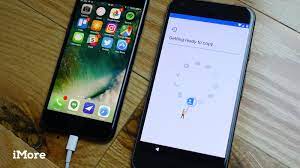Switching over will be a lot easier if you already use Google and Microsoft apps on your iPhone. In fact, the same goes for any cloud-based apps, including Netflix and Spotify. Because they store everything online, these apps make it very straightforward to jump between devices and across platforms.
If you lean on Google programs, then when you get your new Android device, it should come with these apps pre-installed. All you’ll have to do is log in, and your data—your archived Gmail emails, your Google Maps history, your Google Chat messages—will appear.
In general, if you plan to switch frequently between Android and iOS devices, stick to platform-agnostic apps that work similarly on both operating systems. They’ll make the process extremely easy. However, if your iPhone relies heavily on Apple’s own apps, then the swap will require a substantial amount of work, because Apple doesn’t make many of its programs available on Android. Read on for more information on dealing with this issue.
To keep track of your past chats, you’ll want to bring your iMessage and email conversations with you. That’s only partially possible.
The sad fact is, you cannot transfer your iMessage conversations directly from iOS over to Android. Apple doesn’t make an Android version of its app, nor does it allow any other developers to access it, so you’re out of luck. Mac users can check iMessage from their computers, but others won’t be able to access the app after jumping to Android.
So before you leave, make sure to de-link your mobile number from iMessage—assuming you’re taking it with you to your new phone. Go to Settings > Messages and toggle off the iMessage switch. Then visit Settings > FaceTime and turn off the FaceTime toggle switch as well. This removes the association between your phone number and Apple’s proprietary services, which will prevent you from having any problems receiving messages or calls on your new Android handset. If you forget to do this step before you get rid of your iPhone, don’t worry—perform the task remotely at this web page.
Luckily, you can bring the Apple emails stored in iCloud—you just need to import them into Android’s Gmail app. Open Gmail on your new phone, tap the Menu button on the top left, scroll down to settings, and select Add account > Other. Now enter your iCloud username and password. If your Apple account uses two-step authentication, you’ll first need to create a Gmail-specific password: Go to your AppleID account manager, scroll down to Security and under App-specific passwords click on Generate password. Now you can either keep using your iCloud email address within the Gmail app, or treat those old messages as an archive and switch to a Gmail address.
First, download the Google Drive for iOS app to your old device. Open it and sign in with your Google account credentials. Next, tap the Menu button on the top left, followed by the Settings and then Backup. Now you’ll see a list of items, including Contacts, Calendar events, and Photos & videos. Select all of the entries that you want to transfer to your new Android phone.
Now, tap Start Backup and copies of your iPhone data will move to Google Contacts, Google Calendar, and Google Photos. Now you’ll be able to access your files when you sign into your Google account on your new Android phone.
A quick note on photos and videos: These files will transfer to Google Photos, which will count against your cloud storage quota. Google Drive gives you a total of 15GB of free storage space, shared across Drive, Gmail, and Google Photos. The latter can really eat up your quota, so if you end up needing more room, you can pay to upgrade. Prices start at $19.99 a year for 100GB.
That said, not all of us choose Apple Music. If you prefer a different app, and you still want to transfer your MP3s to an Android device, you can do so using a computer with YouTube Music. Open your computer’s web browser, head to YouTube Music’s web portal, click your avatar on the top right of the page, and choose Upload music. Now drag tracks from your local storage into your browser window. Your files will sync to the cloud, and you’ll be able to stream or download them through the YouTube Music app on your new Android device.
Movies and TV shows are more complicated, because Apple doesn’t make an iTunes video player for Android. You can watch your existing iTunes videos on other devices, such as a Mac, Apple TV, or iPad, but not on an Android phone or tablet. However, any videos you obtained from non-iTunes sources should be just fine. Streaming apps—like Plex, Netflix, Hulu, HBO Max, and of course Google TV or Google Play Movies & TV—all work seamlessly across Android and iOS. Just log into your account on your new device and you’ll be good to go.
Source : https://www.popsci.com/switch-iphone-to-android/








